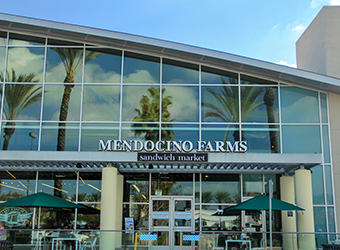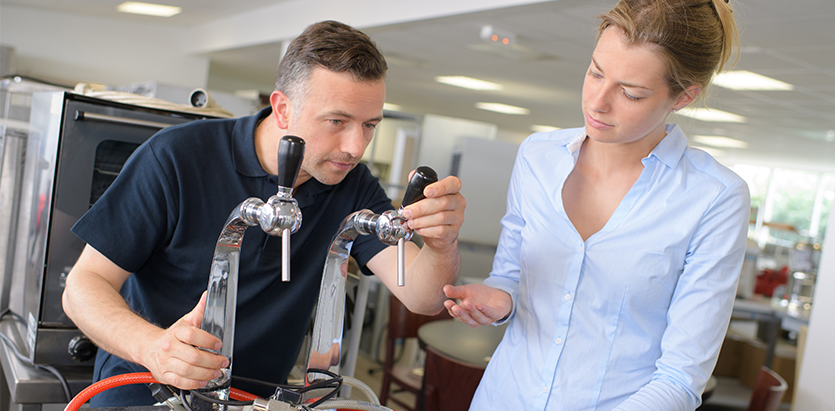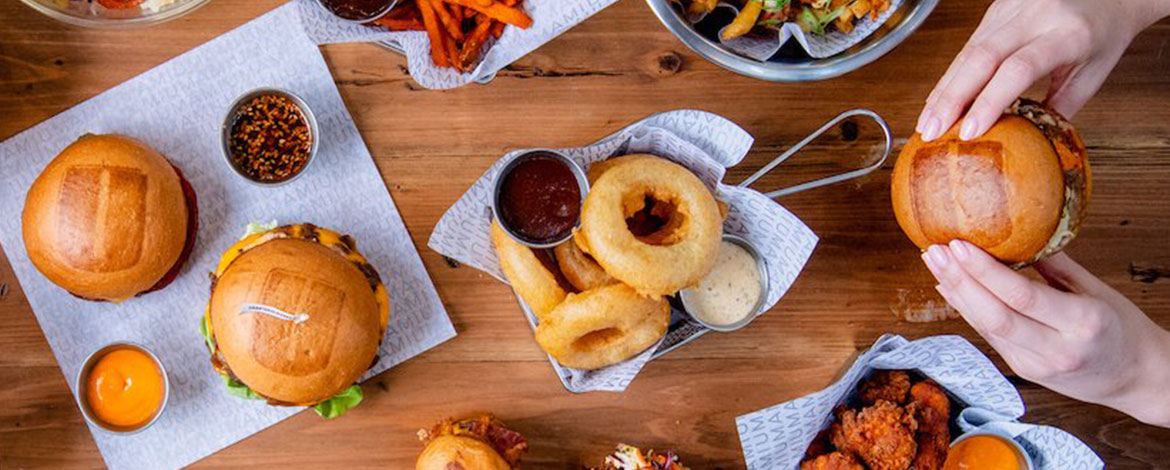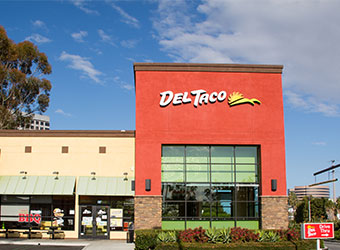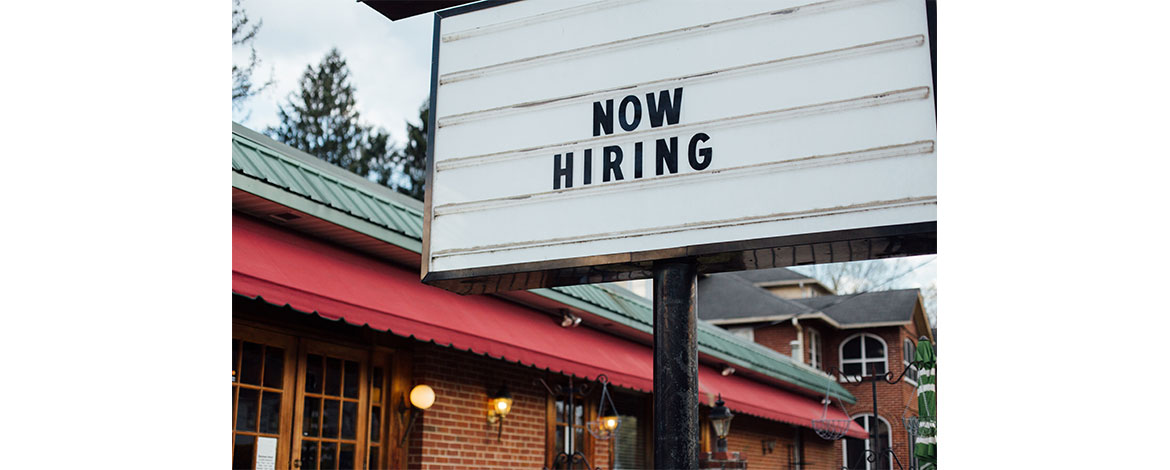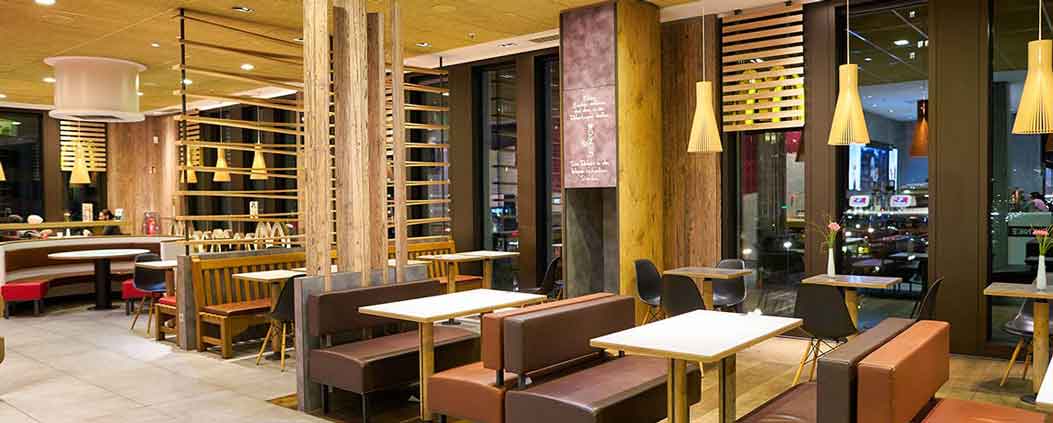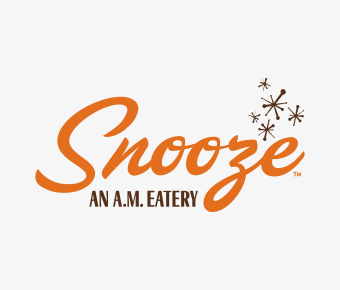Today she’s the Executive Director and CEO of the Restaurant Facility Management Association, but this mosaic-loving, former graphics designer in the oil business and grandmother of two has forged a fascinating, circuitous path to get here. We sat down with Debi Kensell, Executive Director & CEO of the Restaurant Facility Management Association (RFMA) to reflect on her career path and current leadership role at RFMA. Read the full interview below.
Tell us about RFMA and your current role.
RFMA was established in 2004 by a group of restaurateurs that believed there was a unique need of education in restaurant facilities to warrant a standalone association. RFMA was created to do just that, educate, and provide opportunities for members to build relationships with industry partners coming together to network about facilities and vendor needs.
What are the mission and goals of RFMA?
Our mission is to equip restaurant facility professionals to advance their careers and organizations. Our goal is primarily to elevate their status within their companies and within their industry peers. When I started in the association world of facilities there were very few high-level positions within the facilities departments. Today we see VP’s of facilities throughout our restaurant member companies.
How many members does RFMA have?
Over 1450 individual members representing over 250 restaurant brands; we have over 400 vendor companies.
What are some of the benefits of being a RFMA member?
The biggest benefit is building your restaurant facilities network when you join the RFMA family. Members receive free education through webinars and the CRFP Prep Course as well as discounted rates for the CRFP exam and meeting registrations. Each member receives the Facilitator, the official association magazine. We have a weekly newsletter called the Dish to keep members aware of upcoming events and opportunities. As a member they can look up members in areas all across the United States, whether they need a service provider or a peer to discuss needs in a certain region. Our restaurant members always say we’re not trading recipes, just trying to keep our stores up and running, our network helps with that.
What was the path you took to get to where you are today?
Association Management is my second career. I worked in the oil industry for 20 years doing geological mapping of seismic data for Conoco, Diamond Shamrock, and Maxus Energy. While working at Maxus in the late 90’s the company was bought out and the Dallas office was closed. One of my coworkers was helping her brother and several retailers start an association and because of my volunteer work at Maxus for the United Way campaign and the annual golf tournament, she asked me to come on as their meeting planner. I joined Meeting Planners International and began taking all offered curriculum to enhance my meeting planning skills. During my tenure at PRSM, now known as Connex, I was the regional meeting planner and moved into Education in 2003. I joined RFMA in 2008 as the Membership and Education Manager and then became the Education Director in 2010, then after a couple of leadership changes was promoted to Executive Director in September of 2021.
What has been the proudest moment in your career?
I have always been validated by the success of my contributions at each entity, but my proudest moment was when the RFMA Board of Directors put their trust and faith in me to lead the association through my role as Executive Director & CEO. RFMA is one of the best organizations I’ve ever been associated with, and our staff team is one of the best in the industry. Having their respect and support has been invaluable in this new role.
Who has inspired you as a leader?
I had the privilege of working with Tracy Tomson, RFMA’s Executive Director from inception through 2020. I never felt like I worked for Tracy, she had the ability to make everyone feel like they were the most important person on the team while not favoring any of us over the other. She also volunteered for many organizations while running RFMA and raising 3 daughters. She’s a special individual and we remain friends today. I use many skills I learned from working with her to manage RFMA today.
What do you feel is the biggest strength of RFMA right now? Any challenges?
Hands down the culture our members and leadership have created. It really feels like a family reunion when we’re onsite at our conference each year. Our biggest challenge is the ever-changing workspace and economy. We always say our biggest competitor is our member’s time. We put a lot of energy into our conference to make it worthwhile for them to be out of the office.
Tell us about the RFMA conference 2023
We are very excited about our RFMA 2023 conference. The exhibit hall is close to being sold out. Registration for attendees will go live on November 1. We have secured our Keynotes and Signature Speakers and are working to develop curriculum for the breakout sessions. We are in the planning stage for the opening and closing parties, but I promise San Antonio will be a fun host city that will provide lots of time for networking and education.
Is RFMA launching anything new this year for the 2023 conference that we should be aware of?
We have several programs launching this month.
• RFMA kicked off our new Partner Program for our vendor members. The Partner Program is an opportunity for year-round exposure and additional conference exposure for vendor members. Partners receive the exclusive RFMA Partner logo along with extensive benefits at the conference AND all year long. We will be looking for a Leadership RFMA Partner, a CRFP Partner, and a Females in Facilities Partner next!
• We also have an ambassador program for all first-time exhibitors the Vendor Communication Task force has developed. They will meet with first-time exhibitors leading into the RFMA conference on topics such as maximizing the vendor membership, conference schedule review, logistics for show, express exchange, and post-conference conversations. This program is to ensure that all first-time exhibitors have a successful first-year/conference experience. Our goal is that this will lead to developing more sponsors and partners over time.
• During the 2023 Annual Conference we will have the Conference Connect Café which will allow first-time attendees an opportunity to socialize and feel “welcomed” at RFMA 2023. First-time attendees will be matched with a guide prior to the conference. During the event, attendees will have the opportunity to: socialize with their “guide”, meet other first-time attendees, and ask questions about the Conference.
What was your favorite RFMA Conference to date? Do you have a favorite city to host?
My favorite conference was bittersweet. We created a really gorgeous setting for RFMA 2020 and a big send-off for our retiring Executive Director, Tracy Tomson. The day we were traveling to the event cancellations started due to COVID-19. It was an amazing event, but unfortunately, about 250 attendees had to cancel due to travel restrictions and a few of our exhibitors. It was still a great event, and we were very fortunate to be able to execute it. We were the last conference at the Gaylord Rockies during the shutdown. We are doing the Rockies in 2026 and hope all the people that missed 2020 will be able to attend then. Favorite city to host? Nashville was amazing this year. Our attendees seemed to really love the city and venues connected with the conference.
Outside of the RFMA Conference, RFMA holds additional round table meetings, events and opportunities to get involved in some great causes, can you tell us a little more?
We have some really great events starting this month. Please check out the RFMA events page at www.rfmaonline.com to register for anything upcoming. My favorite event each year is our RFMA Gives Volunteer Day. This year were in San Marcos, Texas at the Southside Community Center. We had over 150 volunteers onsite. It was a wonderful day spent with our members improving the Community Center and Retirement Homes so they can better support the community. We do this every year in the city we are hosting our conference. Unfortunately, San Antonio did not have a perfect match for what we do so we chose San Marcos thirty minutes north of the city.
What are some of your interests outside of RFMA?
I have two grandchildren that I love spending time with, I love to get to the beach when I can, and I am a mosaic and stained-glass hobbyist.
Anything additional you’d like to share with us?
Just that I would encourage anyone in the industry who is not yet a RFMA member to join. We really are here as a resource to help you be more successful in your career and for you personally. The friendships I’ve made through RFMA over the past 14+ years mean the world to me. I’m looking forward to seeing many of them in San Antonio, March 19 – 21, 2023.
INDUSTRY INSIGHT
What's Happening at Ecotrak
For some, going to a restaurant is all about the food. For others, the excitement is tied to the experience. If the place has a gimmick, a mini-golf course out back or a waitstaff that belts out showtunes, that just makes the appetizers all the more appetizing.
For us, the sweet spot is somewhere in the middle. While great food engages your eyes, nose, tastebuds and stomach, eating it in a standout environment stimulates your mind and soul as well. All in all, it’s the perfect meal — and it looks way cooler on Instagram.
With that in mind, below are a list of amazing restaurants from coast to coast that will get your mouth watering, your anticipation building, and make you feel like you’ve found the perfect intersection of setting and sustenance. What do the restaurants on this list all have in common other than a killer vibe and delicious food? Answer: They are managing their restaurant facilities with Ecotrak. Check out 13 of our most Instagramable restaurants. How many have you visited?
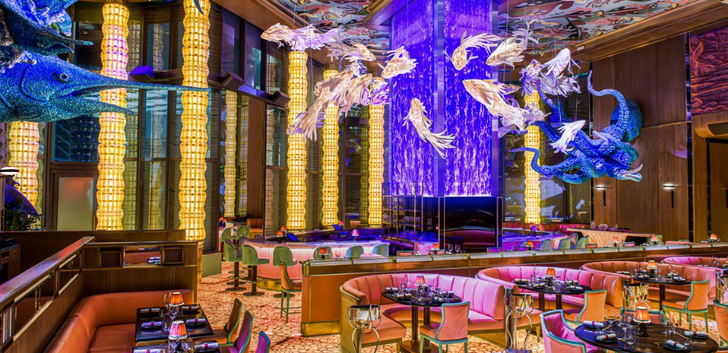
Sexy Fish (Miami)
The motto of this Florida hot spot is “looks as good as it tastes,” and you’d be hard pressed to find food as visually appealing as their Crispy Duck & Watermelon salad with pomegranate, Golden Fish & Crispy Caviar, Beef Tartare with Perigon Truffle or Busby Berkeley-like arrangements of sashimi, gyoza and tempura for days. Surrender yourself to the allure of the omakase, and Sexy Fish’s highly-trained chefs will leave you walking on air.
But if you can turn your gaze away from the table long enough, you’ll be captivated by what has been called “Miami’s most opulent dining room,” fueled with eye-popping artwork by artist Damien Hirst, Frank Gehry-designed fish lamps, and interiors designed to evoke ocean motifs and mid-century brasseries.
As the evening begins, order yourself a theatrical cocktail like the “Smoke & Peppercorn” (pink peppercorn-infused mezcal and sancho pepper tequila), the “Raspberry & Yogurt” (a Grey Goose punch) or “Pumpkin & Spice” (pumpkin and chai cordial with gin, served in a coral-inspired glass) and prepare yourself for something even showier. Mermaid dancers bring “Sexy” back alongside famed DJs and other out-of-this-world showstoppers. Plug into the wind and percussion instruments transporting patrons on an underwater musical adventure, and as the champagne and tequila flows, you’ll be hooked.
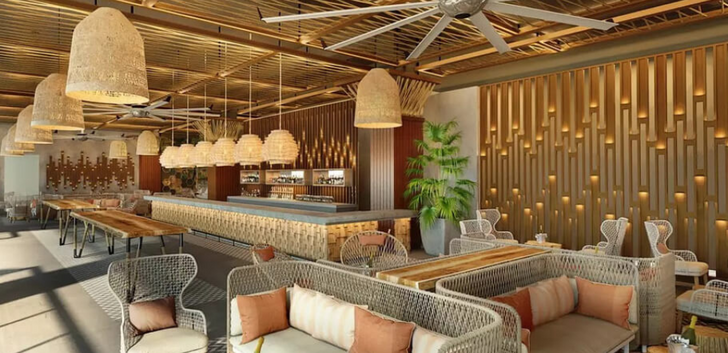
Kassi Beach House (Las Vegas)
In the Gambling Capital of the World, there are so many dining options that it’s easy to get lost. But this Italian coastal alternative, located inside the Virgin Hotels, is no roll of the dice.
The vibe here is the equivalent of attending a celebration at the most amazing beach house you’ve only seen in movies. The dress code is bikinis and trunks, signature punch bowls serve communal cocktails for the table, and it’s all steps from the pool (and reservation-only daybeds), under a disco ball with a thumping musical beat.
The interior is a stunning mix of wood and wicker, boasting huge wraparound booths and walls of ornate ceramics. The daily brunch is a place to see and be seen, as you sip bottomless rose and try a truffle pizza. In the evening, family-style meals, tomahawk steaks and made-in-house pastas are counterbalanced with bottles of wine, negronis and Japanese penicillin.
Imagine yourself and five of your besties, sharing a poolside daybed and sipping Subtropic slushies. What’s the Italian word for paradise?
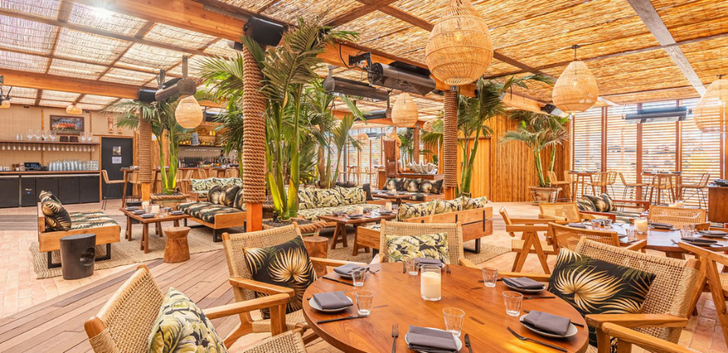
Belles (Venice, CA)
Tiki culture dates all the way back to the 1920s, when South Pacific-tinged dreams of escape first took hold of American culture. Embracing that mindset but stripping away the kitsch, Belles Beach House boasts island vibes and open-wood slats that let a cool breeze blow across one of the best cheeseburgers in town. Then, of course, there are the drinks.
Slip into a flowered booth and sip on a “Heat Stroke” (tequila, passion fruit, mango and smoked cayenne salt), a “Watermelon Mezcal Margarita” or “Seven samurai” (Japanese whiskey, lemon, sour apple, pear and ginger). Feeling social? Get your cocktail of choice in a punch bowl, and watch new friends flock to your table.
Look up from your drink and take note of the one-of-a-kind tiki totem lamps smiling back at you. Thankfully, it isn’t considered impolite to not offer them some of your Lobster Hand Rolls, Butterfly Branzino or Char Siu Pork Ribs with a pineapple glaze. Tiki is a way of life … and sitting in this slice of surfer nirvana, overlooking the Venice Beach boardwalk, another fresh-pressed drink with tequila will get you right where you need to be.
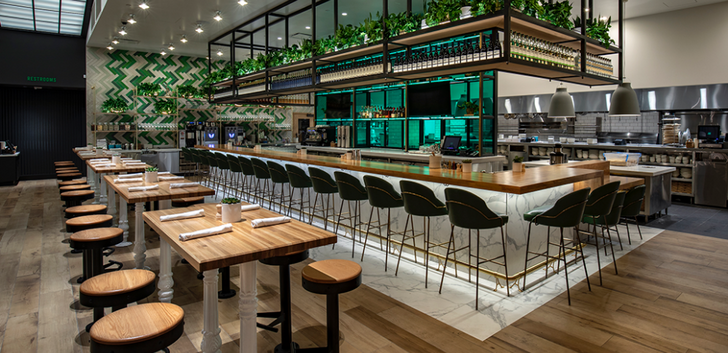
True Food Kitchen (Nationwide)
Employing freshness, seasonality and the principles of Dr. Andrew Weil’s anti-inflammatory diet as its foundations, True Foods has taken a lifestyle once out of reach for most Americans and spread it across 17 states — and growing. Describing their menu as “Fundamentally based on science,” True Food believes that better food leads to better lives, but don’t think such focus on sourcing, sustainability and nutrition robs the food (or their dining rooms) of flavor.
Walking into a True Kitchen, the first thing you notice is that the guests, the dining room and the kitchen have all blended into one ecosystem. It underlines the notion that we’re all on this mission together. The bright, airy restaurant is surrounded by produce and productivity, as culinary experts prepare bright, colorful dishes with potent ingredients like turmeric, broccolini and bok choi. And don’t sleep on the scratch bar, juicing fresh ingredients and preparing syrups for brunch cocktails like the Watermelon Mimosa.
To underline the mentality of a healthy body being in alignment with a healthy mind, True Food Kitchens have been known to offer yoga classes. So stretch your body — and your palate — at a True Food near you.

The Eveleigh (West Hollywood)
The best restaurants are expertly paired with their location, like a great wine and cheese. Look no further than Eveleigh, a country comfort restaurant that opened in its inviting, homey residence about a dozen years ago but feels like it’s been there since the structure was built upon an orchard in 1923. Brunching off the Sunset Strip, as the California sunshine pours through olive tree branches and onto your Dungeness Crab Pasta, you’ll feel perfectly paired as well.
A vine-covered pergola welcomes diners to the outside patio. Indoors, a dining room every bit as bright frames a bartender, working hard on your next favorite cocktail. Whether you want to try a “Negroni Chupacabra” (mezcal, aperitivo, vermouth and prickly pear), “Inbetween Days” (vodka, vermouth, grapefruit, thyme, lemon and soda) or a “Unicorn Juice” slushie, you can’t go wrong.
The Eveleigh really comes to life, however, for large groups gathered around the communal table for 15 (nestled under a retractable, open air roof) or the back patio with a view of the city. Grab some friends, share some sips, and you might find yourselves debating whether The Everleigh is prettier during the day or at night.
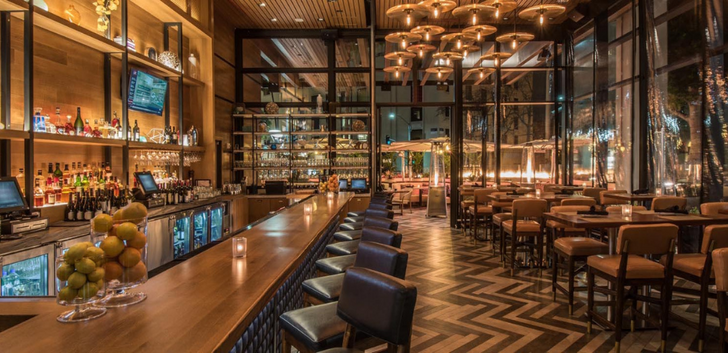
Ocean Prime (Nationwide)
When chef Cameron Mitchell was growing up in Ohio, he used to sit at his mother’s kitchen table and dream of opening elegant fine dining restaurants from coast to coast. Now, his Ocean Prime restaurants are serving up steaks, seafood and cocktails in 18 stunning dining rooms from Beverly Hills to Boston.
Every Ocean Prime feels like its own art gallery, but rather than impressionist paintings on the walls, everyone is oohing and aahing at the Twin Lobster Tails, Colorado Lamb Chops or mouthwatering sides like Black Truffle Mac & Cheese. In Beverly Hills, the massive booths envelop you while you marvel at walls of immaculately-arranged wine bottles. Dallas has smokey slatted windows and a modern outdoor firepit. From the jellyfish-like lamps in Indianapolis to the magnificent coral in Philly, each location seems intent on one-upping the others in opulence.
At the center of it all, however, is Mitchell’s meticulously-orchestrated menu. Taken together, the experience is a spectacle that thrills you from the inside out —it’s enough to make any mother proud.

Katsuya (Nationwide)
Arguably the progenitors of modern art-is-everywhere dining, master sushi chef Katsuya Uechi and design maestro Philippe Starck have spent a decade launching stunning locations from Hollywood to Manhattan. Each is a reflection of its location, from the chill vibes of Brentwood to pulsating South Beach, whose location in SLS South Beach boasts a Tower Penthouse designed by Lenny Kravitz and featuring unique, curated dishes and vintage vinyl.
In New York, diners congregate under Japanese uchiwa fans while devouring Chef Katsuya’s signature Baked Crab Handrolls. In the Bahamas, traditional Japanese cuisine is mixed with California style surrounded by dangling chandeliers and striking art. In Hollywood, servers shout “irashaimase!” before you get to work sipping a “Burning Mandarin” and nibbling on Crispy Rice with Spicy Tuna in their black-and-gold dining room.
Whether sitting in the sushi bar or holding court in a dining room made to see and be seen, Katsuya has spent a decade as the gold standard.
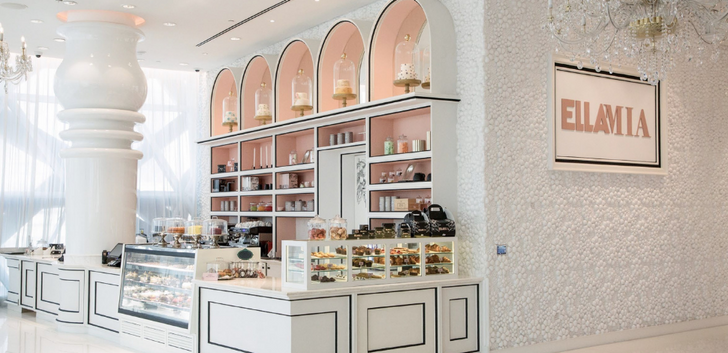
Ella Mia (Worldwide)
To some, coffee is a necessity. To others, it’s a ritual.
Pay your respects to the most sacred of beans in these sophisticated, contemporary spaces that couldn’t be further removed from your grandpa’s coffee shop. Whether you’re in Doha or Dubai, New York or London, you’re bound to have your eyes opened — and not just by the caffeine.
Each EllaMia has a clean, distinctive look marked by brightness and warmth. Glass cases display amazing pastries, including tarts and cakes. Sip on a Rainbow Latte, enjoy it with a slice of Fig & Rose cake, and wonder if this might just be Willie Wonka for grown-ups.
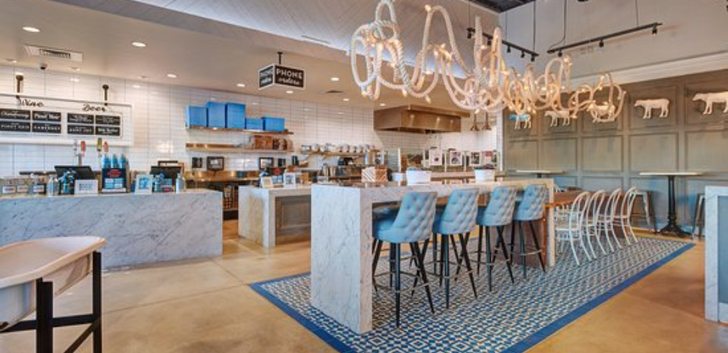
Mendocino Farms (Western US)
When you’re looking for sandwiches, salads and other foodie faves that are fast — but most decidedly not fast food — look for the blue cow.
Since 2005, this rapidly-growing chain (mostly throughout California, now expanding into Texas) has been the go-to for lunchtime treats like the Sweet Heat Crispy Thai Chicken Sandwich, Mrs. Goldfarb’s Unreal Reuben and Pork Belly Banh Mi (with a vegan version, for those so inclined). But the “Soulful Salads,” with ingredients like avocado, quinoa, grape tomatoes, pink lady beets and Impossible chorizo, are delicious enough to make you forget you’re eating so healthy.
If you catch their seasonal specials at the right time, you might be able to snag the delectable Oaxacan Potato Salad or mouthwatering Thai Watermelon & Cucumber Salad. Enjoy it all in a clean, bright dining room with whimsical details like foosball tables, turf-lined seats, and cows on the wall. Most locations also have a children’s play area, so you can enjoy a Chimichurri Steak & Sashito Bowl while your little critters enjoy time on the farm.
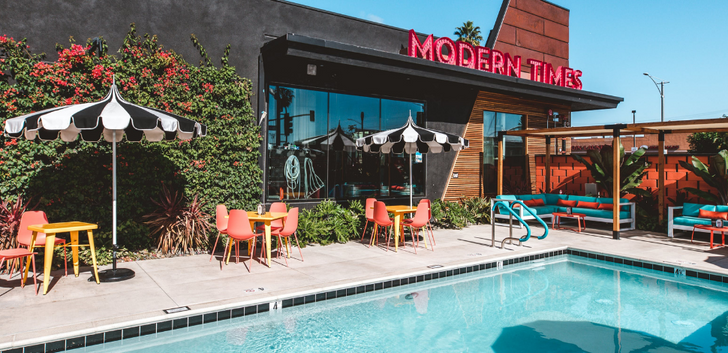
Modern Times Brewery (Anaheim)
The OC’s “Leisuretown” aims to be a permanent block party, and anchoring it all is Modern Times — the collection of brewers, coffee roasters and culinary experts who formed a Justice League-like cadre of flavor in 2013, opening a brewery and tasting room in Point Loma.
This, their fourth location, is also the most off-the-wall. A combination brewery, restaurant, café and swim club, the property is anchored by a serene swimming area whose stated mission is to put visitors “in a dimension of epic and abiding chillness.” Bringing the leisure to Leisuretown, a brightly-colored pop art bar houses 70 brews and ciders on tap, house-roasted coffees and an extensive wine list.
Their 100 percent plant-based menu includes no-brainers like avocado toast and corn fritters, but also outside-the-box dishes like “Fuegolote” (fried corn on the cob with house-made tajin) and the “Munchwrap” (Impossible taco mix, queso and more in a flour tortilla). Swing by their mini-mart for some “sexy merchandise,” order a flight, and find yourself a sun lounger by the pool. Instant glimpses for The Gram.
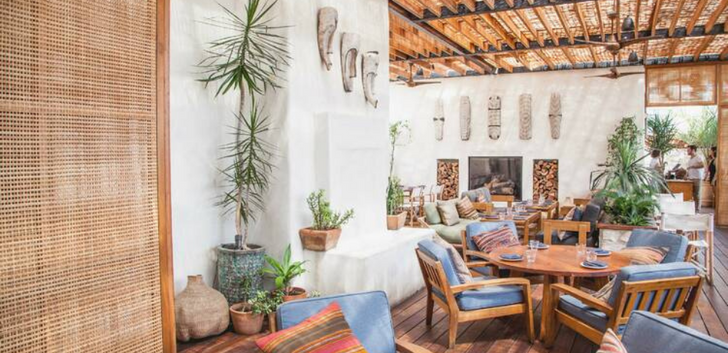
Elephante (Santa Monica)
Who doesn’t dream about owning a beach house, enjoying pitchers of cool drinks and amazing food? Dream no more; just get to Elephante at sunset.
Patrons of this rooftop bar and restaurant enjoy a Southern Mediterranean chill without needing to board a plane. The flavors of Italy inspired hand-crafted cocktails like “The Book Thief” (nosotros respado, cocchi rosa, lime, honey, peach and allspice), “Golden Hour” (bourbon, apple, lemon, vanilla and cinnamon bitters) and a “Coconut Negroni” keep things cool. Enjoy one (or three) with some Polenta & Mushrooms, Diver Scallops or a family-style Veal Milanese for the perfect evening.
The real show here, however, is on par with any band or DJ you could hope to hire. Every evening, the patio is packed with onlookers, watching the one-of-a-kind Southern California sunset into the Pacific Ocean. At Elephante, it’s an experience you’ll never forget.
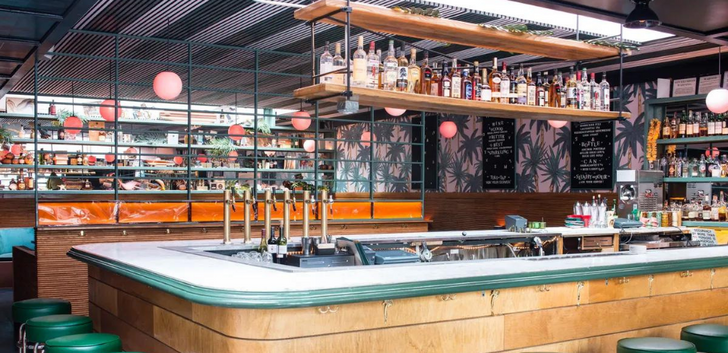
The Happiest Hour (New York)
Cartoon palm trees, flamingo tchotchkes, whimsical drinks, diner-style food and a rock ‘n’ roll soundtrack — what could be happier? This New York hotspot opens weeknights at 5pm and keeps the happy hour vibes going all night long, and there’s no better place to unwind after a hard day at the office.
Grab some co-workers and order up a bunch of Mac + Cheese Bites, Loaded Tater Tots or Extra Crispy Wings for the table. Then design your own “mule kick,” “pineapple express” or “ice cuba” — just pick your spirit, and they’ll happily pour. If a cocktail pitcher or bucket o’ beer is more your style, there are no judgements here.
Perhaps the most “must try,” however, is the so-called “Happiest Burger.” Zagat ranked it as one of the hottest burgers in NYC, Thrillist called it “absolutely delicious,” BlackBook described it as “impossibly mouthwatering” and a national burger critic ranked it among the best burgers in America. At the Happiest Hour, this amalgam of burger, bun and bliss shines even brighter than the disco ball hanging from the ceiling.
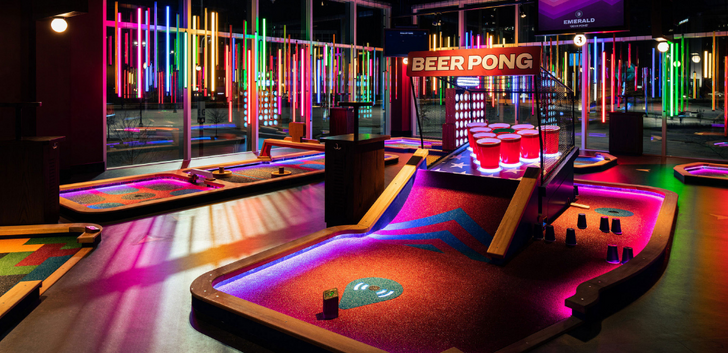
Puttshack (Nationwide)
First, we got nightclub bowling alleys, then nightclub axe-throwing and driving ranges, and now comes a similarly beloved pastime receiving a 21st century update: Mini-golf.
Meet Puttshack, a fast-expanding chain that brings food, drinks and fun to a game now going decidedly high-tech. Faster than you can scream “Holey Moley,” you’ll be hooked on this version of putt-putt, powered by “Trackaballs” with sensors in them that allow the game to keep score for you: A hole in one is worth 50 points, 5 swings is worth 25, if you need more than 10, well, the game mercifully stops counting. There are hazard traps that threaten to rob you of points, Supertubes that can give your ball an express lane to glory, and themed holes like “Prize Wheel” (where a “Price is Right”-like wheel can win you pizza), “Beer Pong” (hit your ball in the “Freshman” cup for a Supertube hole-in-one) or “Ring of Fire” (are you enough of a daredevil to try and knock your ball through the hoop?).
Sip a beer while you take your swings, then adjourn for some world class cuisine that couldn’t be further from amusement food. Flatbread Pizzas, Empanadas, Rendang Bao Buns and Tuscanu Pork Porchetta sandwiches might make you feel like you’re eating in a fancy restaurant, even if you are within eyeshot of a sign that reads: “Oh my God, Becky, look at her putt.”
INDUSTRY INSIGHT
What's Happening at Ecotrak
Image Credit: Umami Burger
Some people might tell you the restaurant industry is at a crossroads. Adam Rinella, however, will be the first to tell you that it’s actually at the intersection of about a dozen crossroads.
“It’s really exciting to be at the end of the tunnel and seeing the light,” Rinella, the Senior Vice President of Development at C3 says after a year lost to COVID-19 lockdowns, yet one that has afforded smart industry execs the time to plan a path forward. “There’s a pent-up demand right now. We’re seeing sales in the markets that have re-opened early — Texas, Florida — that are 20 percent higher than they were in 2019. People want to go out, they want to go to restaurants and get back to regular life.”
A division of lifestyle hospitality company SBE, C3 spent much of 2020 navigating the unprecedented pandemic — while simultaneously exploring opportunities via ghost kitchens, celebrity influencers, software development and food halls that Rinella sees as potential ways to capitalize on this “pent up demand” and emerge with a business stronger, smarter and more nimble than ever before.
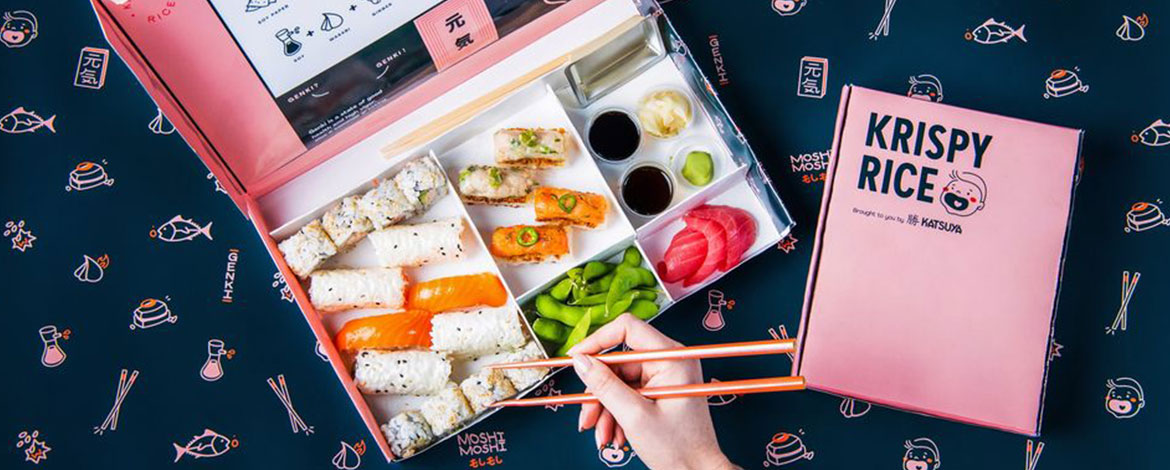
Image credit: Krispy Rice
Maintaining the culture
“We operate 20-plus brands, and we do that through a variety of kitchens,” Rinella says of a C3 roster list that includes big names like Katsuya and Umami Burger, paired alongside rapidly growing delivery-only concepts (at least for now) like Sam’s Crispy Chicken, Plant Nation and Krispy Rice — which saw triple its expected business during the shutdown and currently has 40,000 followers on its lively Instagram without so much as a single location.
Even before shutdowns accelerated mass adoption of delivery apps, C3 experimented with “ghost kitchens” and “dark kitchens,” but the company quickly realized such departures didn’t promote the sort of culture it wanted to embrace.
“We realized pretty fast that we’re in the hospitality industry, and when you eliminate the front-of-house piece, you lose that ability to connect with the customer,” he explains. “It was kind of a dismal operation.”
So instead, they pivoted to a plan where they would use existing kitchens in brick-and-mortar restaurants and hotels, simply setting up additional stations for the delivery-only brands. But even that plan, early on, had its hiccups.
“We figured out something really quickly,” Rinella laughs, remembering the confusion as drivers arrived at Umami Burger looking for a sushi restaurant. “The first day was a disaster. We had all these drivers showing up to the location, and they would put into the app ‘this restaurant doesn’t exist, it’s not here.’ We realized you’ve got to have some kind of way of finding signage for the drivers so they know they’re in the right place. We very quickly came up with a system of A-frame signs, wall signs and parking spaces.”
Now that those initial kinks have been worked out, C3 has positioned itself to thrive. Today, virtual and brick-and-mortar brands share space in their vibrant kitchens — and instead of retro-fitting such spaces to make room, future kitchens will be constructed with these shared-space learnings in mind.
“Now, we’re designing from scratch versus converting existing kitchens, and we’re designing them in a way that will cross-utilize equipment across brands and be set up in a way that considers which concept can be set up next to which concept — which will allow cross-utilization of equipment, labor and even ingredients,” he explains. “We’re getting things down to a science, and focusing on using every square inch of the kitchen to accommodate five, six, seven brands rather than just converting from an existing, single kitchen in a traditional restaurant.”
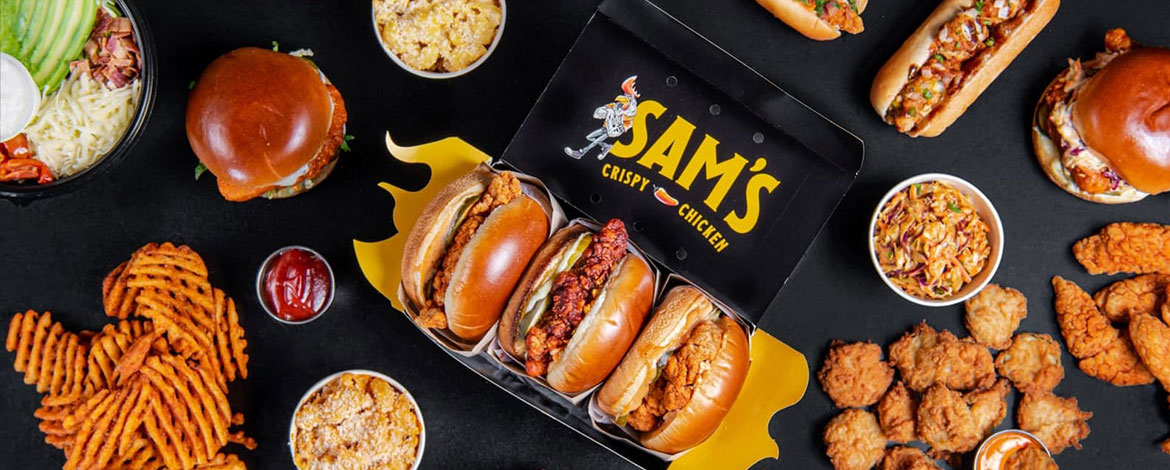
Image credit: Sam's Crispy Chicken
Friends in high places
When SBE began as a nightclub company in the early 2000s, founder Sam Nazarian learned how to harness the power of celebrity. Such lessons have carried over to SBE, and today the company’s well-established relationships with influencers are paying off.
“There are so many choices when you go on DoorDash or Postmates; you have to know how to stand out,” Rinella explains. “One thing that has been brought along from our legacy SBE days is the social influencers, the celebrities and other things that were part of the nightclubs being very popular. Now, when we’re building these fast-casual brands, whether it’s through a ghost kitchen or brick-and-mortar, if you have huge celebrities and social media influencers endorsing your brand through their social media, that can be a huge differentiator.”
Hollywood power couple John Legend and Chrissy Teigen have professed their love for Krispy Rice, with Teigen telling her 34.7 million Instagram followers “you must order from them, and do not skip the shrimp!”C3 has also been working with the likes of Justin Bieber and Diplo.
“Sam has genuine friendships with these people; he’s known them forever, so he introduces them to the food,” says Rinella. “They’re not going to endorse something unless they think it’s of quality, and it’s on-brand for them ... it’s an intrinsic quality of C3 that we attract those people and they want to be a part of it.”
With such connections in mind, Rinella watched closely as Jimmy Donaldson — the 22 year old YouTube sensation known as “Mr. Beast” — recently sold more than a million burgers during the pandemic by launching a ghost kitchen chain called MrBeast Burger in partnership with Planet Hollywood founder Robert Earl. The takeaway was clear: to successfully target Gen Z, look to their favorite YouTubers for branding opportunities.
“That was a huge success; people would order the food because they love Mr. Beast,” says Rinella. “So, we went out and partnered with several really big influencers ourselves, YouTubers with between 5 and 30 million subscribers. We’ll be creating brands with these people to do something similar; if you follow them on YouTube or Instagram, they’re going to have these little mini-brands based around them and the food they love, and people will be able to order that food through our kitchens all over the country.”
The difference, Rinella believes, will come from their high-quality brands. With C3 staff trained to not only create memorable food but also delectable food, the company is in a position to make such partnerships not only exciting, but also result in food actually worth eating.
“The way our kitchens are set up, with the equipment and skillset of our back-of-house employees, we’ll be able to produce everything at a very high level where it’s very good and craveable and people will want to re-order it,” he insists. “It will be the same sorts of followers, Gen Z marketing, but we’ll be hoping to execute these partnerships at a much higher level.”

Image credit: Plant Nation
Deck the halls
As the world reopens, Rinella has an eye on two additional emerging fronts: proprietary technology and single-ownership dining halls.
“We’ve created our own technology called CitizensGo, it’s a marketplace that launched a few weeks ago available on the web or via app,” he says. “You can build one cart from several different brands, have one financial transaction, and then have all the food come to you at once.”
If you’re looking to grab lunch for your family or office, CitizensGo eliminates the need to order from two or three different restaurants to satisfy everyone’s cravings. For the customer, the food arrives at the same time, paid in one easy transaction. For C3, instead of giving a sizeable percentage to a delivery app, they can negotiate a more reasonable fixed amount for last mile delivery.
“The fixed rate makes it more profitable and easier to plan. In addition, the data and customer account becomes your own, so you can get them into your loyalty programs and send them offers when you need to increase interaction,” Rinella says. “That’s the big pivot for us, trying to drive people through our own technology and originating the customer on our platform.”
But, there is still something to be said for dining in. So Rinella is always looking to carefully balance the tangibility of real-world locations with the flexibility of virtual brands.
“Rather than individual brick-and-mortar restaurants for all these brands, we’re building food halls,” he says of locations in various states of development in markets like Manhattan, Atlanta and Seattle. “We can say to a landlord, instead of negotiating with ten different tenants for ten different stalls and ten different rent checks, we have all these amazing brands we want to deploy in this community.”
The food halls give customers the type of choice they desire, and C3 the sort of opportunity to fine-tune plans on the fly that they embrace.
“We spread our brands throughout these stalls to make it a real brick-and-mortar place for these brands to live. If for some reason one of the brands doesn’t work in that community, we just quickly flip that stall to a different brand and see if that works any better,” Rinella explains. “So, the food is being deployed somewhere people can look and touch and feel, while we’re also putting those brands in the back of these restaurants and delivering others via virtual kitchens.”
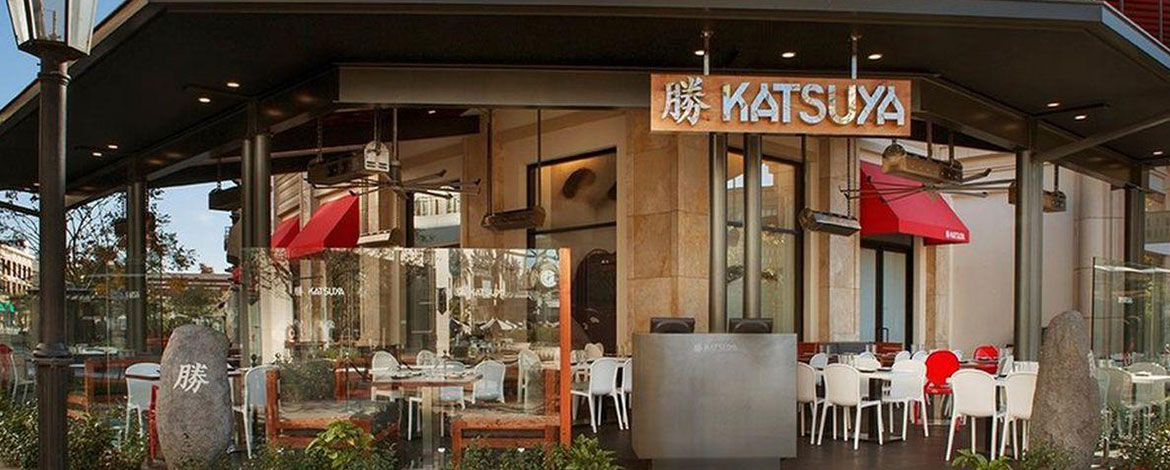
Image credit: Katsuya
Maximizing equipment, minimizing delays
With so many crossroads to be navigated, and so many bold ideas moving the company forward, C3 is thankful for a Facilities Management solution that empowers them to manage their equipment, find footing in new markets and increase operational efficiency.
“Our in-house facilities techs across the country are set up with vendors in Ecotrak,” Rinella explains. “For managers, that gives them the ability to send work orders to an in-house technician or vendor using a standardized system and protocols, whether they need an in-house person to come out, or a vendor.”
As Rinella and his team move from their California strongholds to expansions in Chicago, Austin, Miami, Atlanta and other markets, they also find it immensely helpful to have a system that recommends proven, competent local vendors.
“If it’s a new market, we’re able to get feedback and recommendations from Ecotrak on vendors in that market, and we can onboard them so that right away, when the store opens, the restaurant managers have the ability to place work orders if they’re having some sort of trouble with facilities,” says Rinella.
It also empowers staff at all levels to keep things moving in the right direction. “The facilities manager becomes an air-traffic controller, seeing everything and evaluating work orders as they come in, giving feedback to the managers and helping them troubleshoot, managing the technicians and the vendors,” he adds. “Ecotrak is a huge tool for being able to see the 30,000 foot view constantly, while at the same time managing individual work orders and problems in real time.”
With palpable excitement around the re-opening restaurant industry, and customers eager to interact with brands both established and new, virtual and otherwise, C3 is re-opening businesses with the confidence that they’re in a position to succeed.
“We’re growing incredibly fast,” says Rinella. “Having Ecotrak as a tool on the facilities side allows us to scale quickly.”
INDUSTRY INSIGHT
What's Happening at Ecotrak
As your business shifts from no or low capacity to full capacity, it's time to review your hiring practices.
The COVID-19 pandemic had an enormous impact on nearly all areas of business, including your staffing. But now, capacity restrictions are beginning to ease.
While this is certainly good news for facilities, this new phase comes with its own challenges. Your next phase of re-opening? Staffing your facilities to meet new demand from your customers, in the middle of a hiring shortage.
If you are ready to ramp up your hiring for the upcoming season, it's worth examining your employment process. Here are eight hiring tips to start with as you prepare for full capacity.
1. Target your jobs postings
The vast majority of job candidates are now starting their job search online. While a digital job board means you may be able to reach a wider audience than before, this wide net can also be a challenge.
If your positions are in a niche area, like hospitality or retail, consider using industry trade publications, university job boards, or certain social channels to post your listings. You are actively recruiting candidates, so post your jobs to reach the best applicants where they are.
If you use large job sites, consider leveraging geo-targeting for your posts to get your listing in front of workers who live in your area. Local applicants may already be familiar with your business, or at the very least, a long commute won't be a discouraging factor.
2. Write descriptive job roles
Almost every single industry seems to be hiring right now. Why should someone choose to apply for your company?
Many facilities jobs can look similar on paper. The responsibilities may overlap significantly between similar positions at different companies. With this in mind, don't open a job description with just the bulleted list of responsibilities.
Instead, capture a candidate's attention by highlighting the strengths of your company. Talk about the culture and mission. Leverage current team member testimonials or descriptions. Make it clear to a potential applicant why they would love to work with your company before you go into the details of the role.
Next, although you want to be creative in describing your business, make sure to still optimize your posting for what candidates are searching for. While "mixologist" may sound exciting to you, the perfect candidate may be searching the common word, "bartender". Use the most common and simple job title for an open position.
Finally, make sure that you include a salary or wage range for your postings. It's a competitive hiring field right now, so being upfront can be an advantage. Avoid general phrases like "plus tips" or "signing bonus." When candidates know that your wages will cover their cost of living, they will be more likely to apply.
3. Look for ambition, not just experience
In today's hiring shortage, you may not be able to find candidates with every single skill that you need for the role. However, ambitious applicants can usually learn the skill sets required. When interviewing for a role, look beyond an applicant's on-paper job experience to see their potential. While this will require investing in employee training, it is also an opportunity to teach an employee the exact skills they need for your company.
In addition, if you have found a candidate who is a good fit for a role, don't wait to make the job offer. Most job applicants are applying to multiple places at once, and in today's labor crunch, they may receive other job offers quickly. If you find someone who is a good fit, consider making the job offer as soon as possible—potentially on the spot, or within 24 hours.
4. Feature a professional career page
Potential candidates aren't just looking for a job; they are looking for a career. Let them know that they've found the right place. Communicate that working with your company isn't just an hourly opportunity, but an opportunity for career advancement.
Showcase this career path prominently on your website with a "careers" page. Make this commitment obvious by naming the page Careers, not Hiring or Jobs.
Use the page to show potential applicants how you invest in employees and encourage retention, as well as what job perks and benefits you offer. It's also an opportunity to demonstrate what your team culture looks like and how you celebrate current employees.
5. Prioritize assessments and pre-screen questions
If you are ramping up your hiring for the foreseeable future, an Applicant Tracking System (ATS) can help streamline the process and keep it easy for both your hiring managers and applicants. Many managers know the struggle of scheduling multiple interviews and discover that most people don't show up.
Using assessments and pre-screen questions through your ATS can help ensure that only the most committed applicants are moved through to the interview round. With these questionnaires, you can not only assess the skill levels of applicants, but you can also see who is more likely to follow through. When applicants take the effort to go through these extra steps, you know they are much more likely to show up and engage in your in-person interviews.
For the applicant, these assessments and pre-screen questions can serve to become invested in the role and see that a facility is taking the hiring process seriously.
6. Champion diversity and inclusion
Diverse, inclusive teams are talented teams. Work toward your diversity and inclusion goals by using what resources you have, like your applicant tracking system.
If your ATS meets diversity and inclusion standards, it can help your management create a repeatable, thorough evaluation process. Interviewers can use the ATS to rate candidates based on the same consistent framework. With these metrics in hand, your managers can compare applicants on equal terms during the hiring process.
7. Focus on retention
If your business demand is growing again, it's inevitable that you will need to do more hiring. However, in the rush to hire new employees, make sure that you don't forget to prioritize retention of existing staff as well.
All employers know that high turnover is costly. When you need to fill an open position, you must recruit, hire, onboard, train, and go through a period of employee development. If you cannot fill the open position right away, you also have the cost of operating your facility with an unfilled team role, which can be difficult for your existing staff and affect customer service.
To avoid this cost as much as possible, examine your retention track record. Traditionally, retention tactics commonly center around increased pay, adding benefits, and career advancement opportunities. While these should still be a focus, you may want to go even further.
The past year has been difficult for workers and companies alike. Consider examining your company's accountability, flexibility, and investment in employees, and how these policies may impact retention.
Your company culture affects retention, for both your current employees and any future ones. The goal? To have your current staff telling their friends and family what a great place your company is to work.
8. Consider implementing a referral bonus
Finally, alongside retention, consider using your current staff as recruiters to help you find new applicants. Current employees can be an asset to help you attract quality applicants. A referral program can get everyone involved in the recruiting process.
Before implementing the program, make sure to communicate to employees why you are working with them for referrals: because you want more employees like them. If your staff feels invested, they will likely be more helpful in your referral search.
Of course, your referral program should also include a referral bonus as incentive. Make the bonus large enough to matter (something no less than $250) and pay it quickly (no less than 90 days). Making the bonus meaningful and timely can help your staff understand the beneficial impact of a great referral.
Conclusion
As business ramps up to full capacity, it's more important than ever to invest in quality recruitment and retention. With these tips in mind, you can be better prepared to meet the challenges of full staffing once again.
Restaurant365 incorporates restaurant accounting software, restaurant operations software, inventory management software, payroll + HR software, and scheduling software into a cloud-based platform. R365 HIRE makes it easy for you to filter, hire and onboard the optimal employees for your business.
INDUSTRY INSIGHT
What's Happening at Ecotrak
Image Credit: Mendocino Farms Sandwich Market
Mendocino Farms opened its first cloud kitchen in Long Beach, California in November 2020. We caught up with Gene Davis, CRFP, Senior Director of Facilities, to talk facility management technology, cloud kitchens and how the brand fared during the pandemic.
Mendocino Farms recently implemented Ecotrak Facility Management Software. Why did you go with Ecotrak?
We were with ServiceChannel, and we switched to Ecotrak. I've spent a lot of time with ServiceChannel. I rolled out ServiceChannel in my last two companies, and Mendocino Farms already had ServiceChannel. I knew about Ecotrak, and after seeing their demos, I decided to switch. ServiceChannel served us well, but Ecotrak is more intuitive, easier to use, has more analytical tools, and for our younger managers, it's mobile-based and just a cooler technology. The other reason is the price. ServiceChannel and Ecotrak offer similar features, but ServiceChannel tacks them onto the price. Everything was a la carte. With Ecotrak, we get one price and all the features, and that was appealing to us.
How has your customer experience been with Ecotrak?
I've received great service during the transition. With ServiceChannel, if you have a problem, there's a help desk. You submit an email and it goes back and forth. Ecotrak has amazing support. They have somebody manning the phone 24/7. If I have a question, I like to pick up the phone and talk to somebody versus typing a message like a service request and then waiting for an email response. I’m in California; my stores are in California, and Ecotrak is based in California. I'm excited about having a better support system. That was a big factor.
How is the transition going?
It’s good. We have a client success person, Michael, who is great. It was easier than I thought it would be. The salesperson said, "This is going to be really easy." And I said, “Okay, great,” but I was skeptical. Nothing is easy, especially in facilities. Anything that can go wrong will go wrong. But we've had weekly calls. They've done a lion's share of the dirty work: the loading of assets and PMs. We're about to start the final phase: training. They have a great trainer and training program.
How have your restaurants fared during the pandemic?
Our brand is delivery heavy. That’s one of the reasons we've done so well during the pandemic. The brands that had drive-through and delivery in place made it through.
The company opened its first ghost kitchen. Why don’t you call it a ghost kitchen?
People call them ghost kitchens or virtual kitchens, but we say cloud kitchens. “Ghost” sounds like there's nobody there, but there are lots of people at our cloud kitchen.
Did Mendocino have a cloud kitchen before the pandemic?
No, we opened one in the middle of the pandemic. At the time, opening restaurants was difficult. It was easier to open a cloud kitchen. It shares a facility with 12 or 13 other concepts.
What challenges did you face with opening the cloud kitchen?
Two ways. They can use popular food-delivery apps, such as Grub Hub, Uber Eats, Postmates or Door Dash – we partner with all of them – or use the Mendocino Farms app. Customers can also pick up their orders. The facility has food lockers. A staff member tells them their locker number. It’s contactless since they paid on the app. On our website, it's promoted as “Long Beach Kitchen – Delivery and Pickup Only” to make that clear for guests so they don't get dressed up and show up for dinner at that location.
Does the cloud kitchen support catering?
Yes. Pre-pandemic, catering was an enormous part of Mendocino Farms’ business. We were known for our catering. So, we hope, as people go back to the office, and things slowly go back to whatever the new normal is, that we will be catering a lot more out of Long Beach.
Are there more cloud kitchens in Mendocino Farms’ future?
We've had great success with the first one. Sales are great. The Operation is great. So, we're looking at a couple of different sites – one by Berkeley and one in San Francisco. The small footprint makes it easier to add more to our portfolio. We're convinced that adding more kitchens will strengthen our brand.
What trends have you noticed?
Consumer behaviors have transitioned to online ordering. People like having their groceries delivered because of the convenience. This translates to cloud kitchens well. People will continue ordering food online for delivery or pickup. People get into a routine and it becomes the norm. People are used to it. They're comfortable with it, and they like the new way better in some cases.
Gene Davis , CRFP, is the Senior Director of Facilities at Mendocino Farms Sandwich Market.
INDUSTRY INSIGHT
What's Happening at Ecotrak
Facilities management undergoes constant change and innovation. Everything including work order organization, asset and warranty management, technology interfacing and even the very labor force itself is rapidly evolving. In such a fast-paced industry it’s imperative that professionals reach for the most optimal tools.
In a recent survey conducted by Connex, the leading retail and multi-site Facilities Management Network, 83% of respondents said it is time to change what we call a CMMS. CEOs across the industry agree that term is antiquated and does not communicate what today’s technology systems truly do. Is a computerized maintenance management system (CMMS), which first appeared in 1965, the best title for a tool that aids us in so much more than automated maintenance management?
Focus on the Future
Facility professionals have largely flocked to CMMS because of its automation. The term emphasizes technology. Today, the emphasis is on people and serving their needs. We’re surrounded by computers – our cars, phones, gadgets, kitchen appliances all have computers in them. Saying something is “computerized” sounds dated. Still, these systems are the hub for operators, dispatchers, techs and all levels of maintenance support. However, it is more than just keeping a well-oiled machine humming. It is more than submitting work orders and relying on technology to automate the next steps. These systems help us improve communication and relationships between teams and vendors. They empower our teams to work more efficiently and offer visibility and transparency into the business. Their use cases ripple into all areas of the business, taking maintenance management to the next level.
Artificial Intelligence or AI and its predictive abilities are around the corner. Augmented reality certainly has a role in the future of facility management. Imagine designing, servicing and managing spaces without being physically present. To prepare for the future, we need the right resources, the right people at the helm and a more accurate term for these systems.
Time to Redefine
The term CMMS once hit us as cutting-edge but has since dulled. It’s time for the industry to redefine it. We need a term that encompasses asset management, invoice tracking, project management, business intelligence reporting and analytics, equipment history, and more. We demand so much more from our systems than work order organization and maintenance management.
CMMS technology is steadfast, but the terminology is dated. We have grown out of the term like a pair of old work boots. The technology is poised to tackle new jobs. Whether it is called LCAM (Life Cycle Asset Management), EAM (enterprise asset management), APM (asset performance management), IWMS (integrated workplace management system), IFMS (integrated facility management system), FISH (facilities integrated service hub) or any other combination of the alphabet, a CMMS by any other name would smell just as sweet.
Source: ConnexFM
Mike Snyder is the Founder and Chief Operating Officer of Ecotrak.
INDUSTRY INSIGHT
What's Happening at Ecotrak
After more than a year, the restaurant industry has learned important lessons about how to navigate COVID-19 in 2021 and beyond. Here are seven common lessons that many organizations have learned during recovery.
1. Concepts with existing delivery and drive-through models thrived.
These restaurant brands did not have to re-tool operations to continue serving guests when the pandemic closed indoor dining. Instead, they double-downed on their model by staffing up the drive-through with outside attendants to take and deliver orders. Brands also added double kitchens to maximize output to meet guest demand.
2. Partner with more suppliers, especially regional ones.
The pandemic served as a reminder for restaurants to streamline their procurement processes, consider partnering with more than one supplier, especially a regional one, and nurture vendor relationships to minimize disruptions. It’s also prudent to eliminate difficult-to-source ingredients and broaden the menu to distribute risk.
3. Ghost kitchens are trending.
The pandemic created a high demand for food delivery and pickup service, which has led to the growth of concepts without dining rooms. By minimizing overhead, brands can stay in the black, and staff and guests can stay safe with minimal people in the space.
4. Expand outdoor seating.
In addition to spacing tables to achieve the recommended 6 feet of social distancing, restaurants are also expanding outdoor seating to make up for lost seating in the dining room. They are investing in canopies and heat lamps to extend the outdoor dining season.
5. Promote consumer trust.
Restaurants must ensure guests and staff feel comfortable and safe in their space. Post the company’s detailed covid response on the website. Explain how the brand is keeping its staff and guests safe and healthy. Post scannable signs in the restaurant that quickly detail safety measures. Designate staff whose sole responsibility is sanitizing surfaces throughout the restaurant. Details matter, so provide access to hand sanitizers, keep used and sanitized pens in separate containers, and if staff handles credit cards, wipe them down afterward with sanitizing wipes in guest view.
6. App development for ordering and payment
If restaurant brands didn’t have an app before the pandemic, they do now. The development of apps exploded during the pandemic to give guests a convenient way to order, pay and track deliveries. Even small restaurant concepts benefit from apps as neighbors feel compelled to support local businesses during this time.
7. In-house experts in local governance
Restaurant brands now have in-house experts in local regulations to keep leadership apprised of constantly changing guidelines.
INDUSTRY INSIGHT
What's Happening at Ecotrak
We sat down for a virtual Q&A with Larry Kruguer, former COO of Wingstop Inc., to discuss global restaurant expansion, technology and emerging trends in operations.
Larry served as Chief Operating Officer and EVP for Wingstop Inc., where he led global operations, supply chain, training support and international business initiatives. He also served as VP of International Joint Ventures and Key Markets at The Wendy’s Company., where he led overseas efforts in marketing, business development, real estate and finance.
Today, he leads Floresta Franchise Consulting and serves as a key advisor to Floresta Partners. Additionally, he created KR Ventures, where he serves as Managing Partner/Angel Investor/Advisor in early-stage concepts in the technology, retail and sports-related sectors.
Read the full Q&A with Larry below.
What were some of your career milestones in the restaurant industry?
I entered the industry in 2007 with Wendy’s as head of marketing for its international division. My broad international business background allowed me to re-start the company’s business development efforts. It had not entered a new market in almost a decade and had lost major traction to the other major burger brands. A major milestone was successfully entering major markets and territories it had backed out of prior to my arrival or had never entered. I am most proud of re-entering Argentina and launching Brazil and Chile in South America, re-entering eastern Europe and Japan, and creating a unique menu/retail experience in India.
At Wingstop, I am most proud of being part of the executive team that took the business post-IPO to a very successful run and expansion. My initial role in overseeing the international business included some great milestones, such as building a global team with multi-brand experience and helping to expand into Europe, Latin America and Asia. As COO, the opportunity to oversee the roll-out and expansion of our delivery business, which was completed before the COVID outbreak, has been a major factor in the brand’s continued success despite the pandemic.
What were some of your most memorable experiences at Wingstop and Wendy’s?
Expanding on the above, the opportunity to explore new parts of the world and find ways to grow the respective brands by leveraging their core DNA and understanding the need to adapt to local customs/habits as well as competitive pressures really tested one’s ability to self-evaluate and strategize.
At Wendy’s, developing Wendy’s Café, a more fast-casual experience, differentiated us from other major burger brands and advanced the company’s footprint.
At Wingstop, the opportunity to roll-out delivery overseas helped us refine operational processes when we were ready to launch U.S. efforts. Our willingness to test a more casual dining/sports experience in Mexico allowed the business to flourish. It became the No. 1 market outside the U.S., nearing 100 outlets in 10 years.
What has been the proudest moment in your career?
I am not sure there is one moment. Obviously reaching the level of COO for a highly successful publicly traded company is a proud accomplishment. Yet, I am most proud of the ability over my career to translate my experiences across different stages of a business, multiple industries and challenges into success. I have been asked many times how I was able to cross over multiple sectors and functional roles. My answer has always been if you are always customer-focused, listen to those around you and understand the common threads of success, no matter the industry, you can translate these into successful building blocks.
Who has inspired you as a leader?
I do not have one person who Inspired me. Rather I have had the opportunity to interface with many senior leaders—both good and bad—over my long career, and I have learned from all of them. Early in my career, I was inspired by Stephen Covey’s book, “7 Habits of Highly Effective People.” I was drawn to the ideas of putting yourself in other people’s shoes, treating others as you would want to be treated and creating win-win opportunities. The lessons became the foundation of my leadership/team-player style. People seek an inspirational leader who is consistent, stable and willing to tell it like it is, yet is respectful of others and can balance the highs and lows. An organization puts its faith in a leader who is transparent, consistent and loyal.
To what do you attribute to your success in operations?
I did not grow up in operations; my core background was marketing. I attribute my success to surrounding myself with great seasoned operators and providing them with a customer-focused mentality. We often measure KPIs or processes that have little to do with the end customer. We can be too inward-focused. Success at the end of the day is consistently delivering a fantastic experience to the end customer, which requires operational proficiency. At Wendy’s, for the longest time, it was all about speed of service at the drive-thru. Everything else was a distant second. Our inside dining experience deteriorated; the dining areas became old and tired. The emphasis on speed even outweighed making little mistakes in ensuring order accuracy. There is nothing worse than driving away and noticing your fries are missing. Balancing speed with 100% accuracy with having a great, clean and attractive asset is critical in ensuring customers enjoy their experience and want to come back, time and time again.
Tell us about Floresta Partners and your current role?
Floresta is one of the ventures I am focused on now that I have stepped down from the big corporate world. My partners and I are involved in helping earlier-stage concepts, primarily in F&B, define a clear strategy and growth opportunity. We specialize in defining their development path, asset plan and offering a global perspective if they are a U.S. concept or a foreign concept looking to enter the U.S. market. We have also found a niche in supporting key suppliers/service support providers to restaurants by innovating ways to accelerate their offering and help push the industry towards continued advancement.
As the restaurant industry continues to struggle amid the pandemic, what advice do you have for restaurant leaders?
Be customer-focused. Learn from the challenges we are facing and understand how you can best adapt your business. Most importantly, come out stronger on the other end of this pandemic. Rethink your asset or service formats. Delivery and take-out/drive-thru have been critical during this period, and it’s safe to assume the trend will continue. Maximizing these channels today will have major implications for ongoing success. Are there opportunities to lower your asset investments or improve labor efficiency to better deal with future downturns? Learning from the challenges and keeping the end customer in mind will separate those who succeed from those who may be unable to overcome the current situation.
Headed into 2021, what emerging trends do you think we will continue to see in restaurant operations?
Delivery, smaller asset formats, more narrow menus with fewer SKUs, improved use of labor and ghost kitchens.
What are some tips or tools that restaurant operators can adopt post-pandemic?
Look at brands that have sustained or shown significant growth during the pandemic. They have followed the lessons I have described above, but there may be other tidbits to learn. There is nothing wrong with learning from others’ success.
You are very active in early-stage technology ventures. How important is technology for restaurant and retail operations?
It is very important. In addition to my Floresta efforts, I have invested in early-stage technology companies that are not F&B focused. The common trait is by being customer-focused, the continued improvements that a company can achieve through advances in technology are significant. Technology can significantly improve internal operating procedures that benefit the end customers and deliver new channels for your customers to interface with you. The pandemic requires social distancing, but technology has helped people find ways to communicate, interface and exchange services. Without technology imagine the repercussions on our economy and way of life.
Where do you see technology headed in the next 5 years for the restaurant industry?
I see the involvement of technology accelerating in the next 5 years. With labor costs increasing and the post-pandemic challenges, leverage technology to improve processes, efficiencies and efforts. Technology will be critical in profitability margins and improved service.
Do you have any books or podcasts to recommend?
Actually, my recommendation is to spend more time in your restaurants. Spend time speaking to customers and front-line personnel. Visit other concepts that are growing and expanding or have received great reviews. Patron them and see what they are doing and how their best practices can be adapted to your business. Do not spend too much time behind a desk.
What are some of your interests outside of the business?
I love to spend quality time with my family. I have four children who span in ages from 28 all the way down to 7, so the breadth of conversation, interests and opinions vary quite a bit – keeps me on my toes to say the least! I love to travel globally; COVID has not helped this year and looking forward to starting again later in 2021. Lastly, I love all sports—both as an active participant and as an observer; nothing is better than spending time outside in the fresh air and keeping both mind and body in shape.

